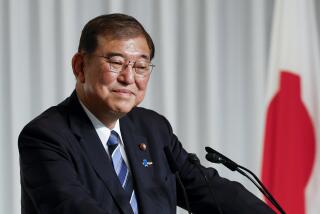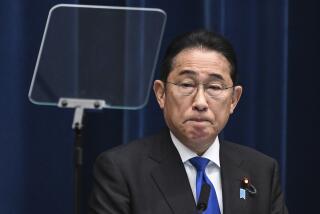Key Defector Throws Support to Japan Opposition : Politics: But ex-Liberal Democrat who leads grass-roots party sets a condition for alliance. Another important rebel does the same.
- Share via
TOKYO — The man in the middle between forces contesting to take over Japan’s government declared for the first time Thursday that he would help create an opposition-led coalition government.
Morihiro Hosokawa, a former Liberal Democrat who leads the 14-month-old grass-roots Japan New Party, said that he intends to throw his party’s votes to an opposition alliance--as long as the alliance does not name Socialist Chairman Sadao Yamahana as its candidate for prime minister.
While the Japan New Party’s 36 votes would help five other opposition groups elect their candidate for prime minister, the party would stay out of a coalition, Hosokawa said.
Masayoshi Takemura, another Liberal Democrat rebel, who formed the New Party Harbinger last month and has promised to bring his 13 representatives into a parliamentary group with Hosokawa’s party, cited a major condition.
The opposition is more fervent about political reform than are the Liberal Democrats, and Takemura said that any coalition must be firmly committed to reform. A split occurred in the Liberal Democratic Party when it squelched reform bills in June. That led to last weekend’s parliamentary elections, in which the Liberal Democratic Party lost its majority.
But it was clear that the declaration by Hosokawa, who built his party from scratch by campaigning against all established parties, struck a heavy blow at the Liberal Democrats’ hopes of continuing to run the government they alone have controlled since 1955.
The Liberal Democrats had hoped to persuade the forces of Hosokawa and Takemura to join them. All other opposition parties have rejected the idea of joining a Liberal Democrat-led coalition.
Now, the once all-powerful party can only hope that the diversity of the opposition non-Communist parties will prevent them from forming a coalition. In that case, the Liberal Democrats could hang onto power through a “minority Cabinet” without a coalition.
“The Liberal Democratic Party has received the verdict of the people,” Hosokowa said in explaining his decision. “It lost a no-confidence vote and it lost its majority in the lower-house election. That shows the people want an end to one-party rule.”
Without the Hosokawa-Takemura forces, the five-party opposition coalition would fall short of a majority in the lower house of Parliament, which elects the prime minister.
Attempts to work out a policy agreement that would become the basis for a non-Liberal Democrat coalition are expected to come to a head next week. The big stumbling block is expected to be the left-leaning Socialists, who consider the nation’s armed forces unconstitutional, who barely tolerate the U.S.-Japan Security Treaty and who oppose generation of electricity by nuclear power.
Thursday’s move toward opposition unity came as the Liberal Democrats fell into dissension.
After Prime Minister Kiichi Miyazawa announced his intention to resign as party president, Seiroku Kajiyama, the party’s secretary general, was forced to withdraw a proposal to choose a new leader through discussions among faction leaders and party elders. More than two dozen legislators condemned his plan in a meeting of legislators from both houses of Parliament.
In the meeting, predominantly younger legislators branded Kajiyama’s idea old-fashioned and anti-democratic. He finally accepted their demand that a secret ballot be conducted in another meeting of the party’s members of Parliament.
Several of the critics demanded that the party accept its defeat and abandon efforts to lead the new government.
Hardly ever has the party’s rank and file disputed a leadership decision. As the party’s split in June illustrated, the outburst underscored a dramatic loosening of the aging factional bosses’ power to control their younger followers.
Miyazawa’s resignation as party president will become effective when a new leader is chosen, probably next week. When Parliament is convened around Aug. 2 to select a new prime minister, he and his Cabinet ministers will resign en masse.
Speculation on who the new prime minister might be remains premature, analysts said.
But on the opposition side, mentioned most prominently is former Finance Minister Tsutomu Hata, another defector from the Liberal Democrats. His new Renewal Party is the only opposition party with broad experience in top government posts.
How Japan Picks Prime Minister
A candidate for prime minister of Japan must be a member of Parliament, from either chamber, and must win a vote of approval in the lower house. Here is the process:
1. Within 30 days of a general election, the incumbent prime minister must convene a special session of Parliament to choose a new premier and lower house Speaker.
2. As soon as the special session is called, the incumbent prime minister and the rest of the Cabinet must resign. However, the prime minister remains in office as a caretaker until a successor is elected.
3. If no candidate wins a majority on the first ballot, a runoff vote between the two top candidates is held. According to Parliament rules, whoever gets the most votes wins, even without a majority.
More to Read
Sign up for Essential California
The most important California stories and recommendations in your inbox every morning.
You may occasionally receive promotional content from the Los Angeles Times.










